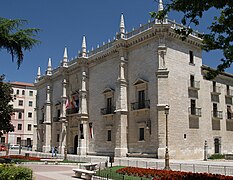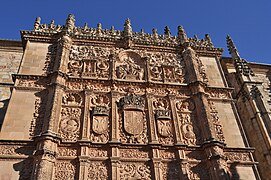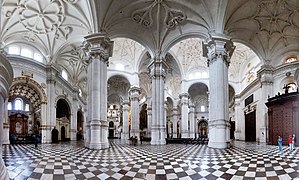Spanish Renaissance architecture
This article relies largely or entirely on a single source. (July 2019) |
Spanish Renaissance architecture was that style of Renaissance architecture in the last decades of the 15th century. Renaissance evolved firstly in Florence and then Rome and other parts of the Italian Peninsula as the result of Renaissance humanism and a revived interest in Classical architecture. It was part of the general movement known as the Renaissance, which spread outwards from Italy and affected many aspects of scholarship and the arts. In Spain, the Renaissance began to be grafted to Gothic forms.
The style started to spread mainly by local architects: that is the cause of the creation of a specifically Spanish Renaissance, that brought the influence of Italian architecture, sometimes from illuminated books and paintings, mixed with Gothic tradition and local idiosyncrasy. The new style is called Plateresque, because of the extremely decorated facades, that brought to the mind the decorative motifs of the intricately detailed work of silversmiths, the "Plateros". Classical orders and candelabra motifs (a candelieri) combined freely into symmetrical wholes. Examples include the facades of the University of Salamanca and of the Convent of San Marcos in León.

The late-15th century Palacio de Santa Cruz, an early example of Renaissance architecture in Valladolid

Plateresque facade of the University of Salamanca

Dome of the Chapel of El Salvador in Úbeda
As decades passed, the Gothic influence disappeared and the research of an orthodox classicism reached high levels. Although Plateresco is a commonly used term to define most of the architectural production of the late 15th and first half of 16th century, some architects acquired a more sober personal style, like Diego Siloe, and Andrés de Vandelvira in Andalusia, and Alonso de Covarrubias and Rodrigo Gil de Hontañón in Castile. This phase of Spanish Renaissance is called Purism.

Courtyard of the Palace of Charles V in Granada

El Escorial, completed in 1584, by Juan Bautista de Toledo and Juan de Herrera[1]

Panorama of the inside of the cathedral of Granada
From the mid 16th century, under such architects as Pedro Machuca, Juan Bautista de Toledo, and Juan de Herrera, there was a much closer adherence to the art of ancient Rome, sometimes anticipating Mannerism. An example of this is the Palace of Charles V in Granada built by Pedro Machuca. A new style emerged with the work of Juan Bautista de Toledo, and Juan de Herrera in the Escorial: the Herrerian style, extremely sober and naked, reached high levels of perfection in the use of granite ashlar work, and influenced the Spanish architecture of both the peninsula and the colonies for over a century.[according to whom?]
List of notable structures[]
- El Escorial (by Juan Bautista de Toledo and Juan de Herrera)
- Texas Tech University (various architects)
- University of Salamanca (unknown architect)
- New Cathedral of Salamanca (by Juan de Álava and others)
- Palace of Monterrey in Salamanca (by Rodrigo Gil de Hontañón)
- Arzobispo Fonseca College in Salamanca (by Diego de Siloé, Juan de Álava and R. G. de Hontañón)
- Convent of San Esteban in Salamanca, (by Juan de Álava and R. G. de Hontañón)
- Palace of Guzmanes in León (by R. G. de Hontañón)
- Hospital de la Santa Cruz in Toledo (by Enrique Egas and Alonso de Covarrubias)
- Hospital de Tavera, in Toledo (by Bartolomé Bustamante)
- Hospital Real, in Granada (by Enrique Egas)
- Palace of Charles V in Granada (by Pedro Machuca)
- Cathedral of Granada (by Juan Gil de Hontañón, Enrigue Egas and Diego de Siloé)
- Jaén Cathedral (by Andrés de Vandelvira)
- Cathedral of Baeza (by Vandelvira)
- Vázquez de Molina Square in Úbeda (by Vandelvira)
- Town Hall in Seville (by Diego de Riaño)
- University of Alcalá de Henares (by Rodrigo Gil de Hontañón and others)
- Royal Collegiate Church of Santa María la Mayor in Antequera, Andalusia (by Pedro del Campo)
- Hostal de los Reyes Católicos of Santiago de Compostela (by Enrique Egas)
- Town Hall of Tarazona
See also[]
| Wikimedia Commons has media related to Renaissance architecture in Spain. |
References[]
- ^ El Escorial Monastery - History of El Escorial accessed 23 October 2006
- Renaissance architecture in Spain
- Architecture of Spain
- Architectural history






